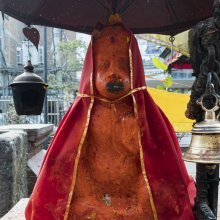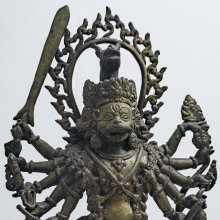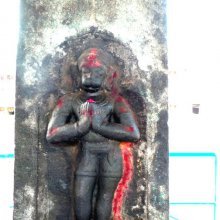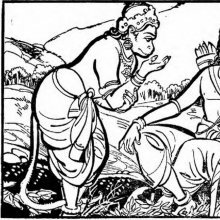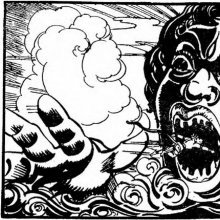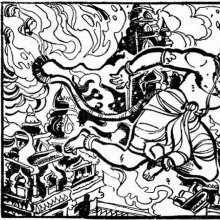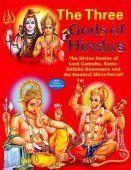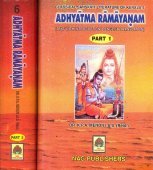Hanuman, Hanumat, Hanūmat, Hanumān, Hanūmān: 26 definitions
Introduction:
Hanuman means something in Buddhism, Pali, Hinduism, Sanskrit, Jainism, Prakrit, the history of ancient India, Marathi, Tamil. If you want to know the exact meaning, history, etymology or English translation of this term then check out the descriptions on this page. Add your comment or reference to a book if you want to contribute to this summary article.
Images (photo gallery)
(+24 more images available)
In Hinduism
Purana and Itihasa (epic history)
Source: archive.org: Puranic EncyclopediaHanūmān (हनूमान्).—A monkey born of the elements and aspects of Devas. In the epics of no other country could be found a character that belongs to the animal kingdom who is as powerful, erudite and philosophic as Hanūmān. Birth. Many and different are the stories about the birth of Hanūmān told in Purāṇic literature, and they are briefly noted below. (See full article at Story of Hanūmān from the Puranic encyclopaedia by Vettam Mani)
Source: archive.org: Shiva Purana - English TranslationHanumat (हनुमत्) refers to the foremost among the Monkeys (Vānara), according to the Śivapurāṇa 2.5.2 (“The Prayer of the gods).—Accordingly, as the Gods eulogized Śiva: “[...] Among all kindred beings you are Dharma. In all stages of life you are Sannyāsa. You are the supreme Liberation in all Vargas. Among Rudras you are Nīlalohita. Among all Ādityas you are Vāsudeva; among the monkeys you are Hanumat; among the sacrifices you are Japayajña; among the weapon-bearers you are Rāma. [...]”.
Source: WikiPedia: RamayanaHanuman is a Hindu deity, who is an ardent devotee of Rama, a central character in the Indian epic Ramayana. A general among the vanaras, an ape-like race of forest-dwellers, Hanuman is an incarnation of the divine, whose fate it is to aid the hero Rama in the struggle against the demon king Ravana.
Hanuman, is seen as the incarnation of Shiva, and sometimes as Vayu (god of wind). Hanuman was born to Anjana and Kesari (a female vanara and a male vanara). According to the Vedas, his mother was an apsara who was born on Earth as a female vanara due to a curse. He was born in Aanjan.
Source: Cologne Digital Sanskrit Dictionaries: The Purana Index1a) Hanumān (हनुमान्).—A friend of Rāma; son of Marut and Añjanā; took part in Lankā expedition; knew the yoga power of Viṣṇu and worshipped along with Rāma in the Kimpuruṣa country; attained final release by satsaṅga. Had the white umbrella when Bharata took the pādukā.1 The best, the wise, the learned brahmacāri, and warrior;2 present at Rāma's abhiṣeka.3
- 1) Bhāgavata-purāṇa IX. 10. 16 and 19; II. 7. 45; V. 19. 1; XI. 12. 6; IX. 10. 43.
- 2) Brahmāṇḍa-purāṇa III. 7. 225-26; IV. 29. 118.
- 3) Viṣṇu-purāṇa IV. 4. 100.
1b) The residence of, protected by Rudra on all sides; there are kuṇḍas special to Sūrya, Brahmā, Rudra and Hari.*
- * Vāyu-purāṇa 59. 118; 60. 73.
Hanumān (हनुमान्) went to Laṃka and in order to find Sītā (wife of Rāma), according to the Vaṃśānucarita section of the 10th century Saurapurāṇa: one of the various Upapurāṇas depicting Śaivism.—Accordingly, [...] Hanumān went to Laṃka and saw Sītā and in order to believe him as the attendant of Rāma, he gave her the ring of Śrīrāma. Jānakī was pleased. On returning Hanumān told everything to Rāma and preparation for war started. Having constructed a bridge across the ocean Rāma went to Laṃka with His army and fought with Rāvaṇa who was killed along with the demon force.

The Purana (पुराण, purāṇas) refers to Sanskrit literature preserving ancient India’s vast cultural history, including historical legends, religious ceremonies, various arts and sciences. The eighteen mahapuranas total over 400,000 shlokas (metrical couplets) and date to at least several centuries BCE.
Shilpashastra (iconography)
Source: Red Zambala: Hindu Icons and Symbols | Inner Circle IVHanumān (हनुमान्) is one of the heroes of the Rāmāyana and he’s the embodiment of wisdom (jñāna) and devotion to God (bhakti) as well as courage and fortitude (bālā). When enshrined alone he is usually shown holding up the mountain or brandishing his favourite weapon the club or Gadā. The club represents Cosmic Order (Ṛta) as well as Karma.
Source: Archaeological Survey of India: Śaiva monuments at Paṭṭadakal (śilpa)Hanumān (हनुमान्) is found as a sculpture on the fourteenth pillar of the southern half of the maṇḍapa of the temple of Trailokyeśvara.—Below in the scroll we have an interesting and rare image of Hanumān singing with a vīṇā. His face and ears are like that of Hanumān’s but the tail is invisible on the image. We can easily notice the gourd on his left shoulder. His mouth is open; that means he is singing. Both his hands are on the shaft of his string instrument. He is singing to the tunes of it.
Hanumān playing on a string instrument is derived from one of the Indian myths. We know that Hanumān after the victory of Rāma in the battle of Laṅkā asked him to bless him with mukti, liberation. Rāma refused to accord it to him. Then Śiva being nādapriya, lover of the sound of music, appeared and promised him to fulfill his desire on the condition that he should sing for him always. Hanumān is known for his music and even a treatise on music goes by his name Hanumamata or Hanumanmata. It is very rare to see Hanumān with a musical instrument. Apart from this example we know another statue of Hanumān in one of the temples at Kumbakonam in Tamilnadu. There Hanumān is sitting with a string instrument and singing.
Source: Shodhganga: The significance of the mūla-beras (śilpa)Hanumān (हनुमान्) is the name of a deity depicted at Ramaswamy Temple in Kumbakonam (Kumbhakonam), representing a sacred place for the worship of Viṣṇu.—(a) In the sannidhi for Rāma, there are icons of Rāma, Sītā, Lakṣmaṇa and Hanumān. [...] (b) In front of the stone images are the utsava-mūrti of Rāma, Sītā, Lakṣmaṇa, Bharata, Satrukguṇa and Hanumān. Hanumān is found seated in padmāsana with two hands. The right hand of Hanumān holds the vīṇā and the left hand holds the pustaka.
Hanumān is also found standing in samapāda-sthānaka with the hip tilted a little to the right. His two hands are in añjali-hasta. There is another sannidhi where Hanumān is found in garudāsana. Hanumān is found carrying Sri Rāma in his two hands. The feet of Rāma are placed on the hands of Hanumān. Here the hands of Hanumān are in patāka-hasta. Rāma is found with four hands. The upper right hand and the upper left hands hold cakra and śaṅkh respectively in kartarīmukha-hasta. The lower right and left hands are in kaṭaka-hasta as if holding the bow and arrow. In this temple one finds that Viṣṇu is found in various postures. These postures can be used for dances. They give a variety and beauty to the dance instead of repetitive actions and postures.
Hanumān is also depicted at the Ranganathaswamy Temple in Srirangam (Śrī Raṅgam), which represents a sacred place for the worship of Viṣṇu.—Hanumān is found in samapāda-sthānaka with hands in añjali.

Shilpashastra (शिल्पशास्त्र, śilpaśāstra) represents the ancient Indian science (shastra) of creative arts (shilpa) such as sculpture, iconography and painting. Closely related to Vastushastra (architecture), they often share the same literature.
Vaishnavism (Vaishava dharma)
Source: ISKCON Press: GlossaryHanumān (हनुमान्).—The great famous monkey devotee of Lord Rāmacandra. The eleventh portion of Rudra. He is the brother of Bhīma and the son of the wind-god, Vāyu, and Añjana, the daughter of Gautama Ṛṣi. The story of how Bhīma and Hanumān met is told in the Vana Parva of the Mahābhārata. Hanumān gave a benediction to Bhīma that he would ride on the flagstaff of Arjuna's chariot and strike terror into the Kaurava troops with earth trembling battle cries. He served the Supreme Lord in His incarnation as Lord Rāmacandra and assisted Him in defeating the demon Rāvaṇa.
Source: Pure Bhakti: Brhad BhagavatamrtamHanumān (हनुमान्) refers to:—The most famous monkey devotee of Śrī Rāmacandra, who assisted the Lord in defeating the demon Rāvaṇa. (cf. Glossary page from Śrī Bṛhad-bhāgavatāmṛta).

Vaishnava (वैष्णव, vaiṣṇava) or vaishnavism (vaiṣṇavism) represents a tradition of Hinduism worshipping Vishnu as the supreme Lord. Similar to the Shaktism and Shaivism traditions, Vaishnavism also developed as an individual movement, famous for its exposition of the dashavatara (‘ten avatars of Vishnu’).
Ayurveda (science of life)
Dietetics and Culinary Art (such as household cooking)
Source: Shodhganga: Dietetics and culinary art in ancient and medieval IndiaHanūmat (हनूमत्) is the name of a deity to be meditated upon before the commencement of the meals, according to the 17th century Bhojanakutūhala (dravyaguṇāguṇa-kathana), which deals with the topics of dietetics and culinary art, also known as Pākaśāstra or Pākakalā.—Accordingly, [...] one must also meditate upon Hanūmat before the commencement of the meals praying thus:—“I meditate upon Lord Hanūmat, the son of Añjanā, so that the effects of evil eyes are ameliorated)” (cf. Bhojanakutūhala I.1476).

Āyurveda (आयुर्वेद, ayurveda) is a branch of Indian science dealing with medicine, herbalism, taxology, anatomy, surgery, alchemy and related topics. Traditional practice of Āyurveda in ancient India dates back to at least the first millenium BC. Literature is commonly written in Sanskrit using various poetic metres.
In Buddhism
Tibetan Buddhism (Vajrayana or tantric Buddhism)
Source: OSU Press: Cakrasamvara SamadhiHanumat (हनुमत्) is the name of a deity, according to the Guru Mandala Worship (maṇḍalārcana) ritual often performed in combination with the Cakrasaṃvara Samādhi, which refers to the primary pūjā and sādhanā practice of Newah Mahāyāna-Vajrayāna Buddhists in Nepal.

Tibetan Buddhism includes schools such as Nyingma, Kadampa, Kagyu and Gelug. Their primary canon of literature is divided in two broad categories: The Kangyur, which consists of Buddha’s words, and the Tengyur, which includes commentaries from various sources. Esotericism and tantra techniques (vajrayāna) are collected indepently.
In Jainism
General definition (in Jainism)
Source: archive.org: TrisastisalakapurusacaritraHanuman (हनुमन्) or Hanumat is the son of Añjanā and Pavana (son of Vidyādhara-king Prahlāda), according to the Jain Ramayana and chapter 7.2 [Rāvaṇa’s expedition of conquest] of Hemacandra’s 11th century Triṣaṣṭiśalākāpuruṣacaritra: an ancient Sanskrit epic poem narrating the history and legends of sixty-three illustrious persons in Jainism.
Accordingly, “[...] Since he had come to the city Hanuruha as soon as he was born, the uncle gave the name Hanumat (Hanuman) to her son. And because the mountain had been reduced to powder by his fall from the car, he gave him another name also, Śrīśaila. Hanumat grew up, playing happily, like a young rājahaṃsa in a bed of lotuses in Mānasa”.
Source: archive.org: TrisastisalakapurusacaritraHanumat (हनुमत्) or Hanuman is the son of Añjanā and Pavana (son of Vidyādhara-king Prahlāda), according to the Jain Ramayana and chapter 7.2 [Rāvaṇa’s expedition of conquest] of Hemacandra’s 11th century Triṣaṣṭiśalākāpuruṣacaritra: an ancient Sanskrit epic poem narrating the history and legends of sixty-three illustrious persons in Jainism.
Accordingly, “[...] Since he had come to the city Hanuruha as soon as he was born, the uncle gave the name Hanumat (Hanuman) to her son. And because the mountain had been reduced to powder by his fall from the car, he gave him another name also, Śrīśaila. Hanumat grew up, playing happily, like a young rājahaṃsa in a bed of lotuses in Mānasa”.

Jainism is an Indian religion of Dharma whose doctrine revolves around harmlessness (ahimsa) towards every living being. The two major branches (Digambara and Svetambara) of Jainism stimulate self-control (or, shramana, ‘self-reliance’) and spiritual development through a path of peace for the soul to progess to the ultimate goal.
India history and geography
Source: Project Gutenberg: Castes and Tribes of Southern India, Volume 1Hanuman (the monkey god) is the name of a deity, worshipped by the Lambadis: a well-known tribe of carriers who are found all over Western and Southern India. Offerings of money are made to this deity for the bestowal of [230]children, etc. When their prayers are answered, the Lambādis walk all the way to Tirupati, and will not travel thither by railway.

The history of India traces the identification of countries, villages, towns and other regions of India, as well as mythology, zoology, royal dynasties, rulers, tribes, local festivities and traditions and regional languages. Ancient India enjoyed religious freedom and encourages the path of Dharma, a concept common to Buddhism, Hinduism, and Jainism.
Languages of India and abroad
Marathi-English dictionary
Source: DDSA: The Molesworth Marathi and English Dictionaryhanumān (हनुमान्) [or हनूमान्, hanūmān].—m (S) pop. hanumanta m The monkey-chief Hanuman, the son of the wind, and the friend, ally, and spy of Ramachandra in his invasion of Lanka. Pr. gāṃva jaḷālā tarīṃ hanumanta nirāḷā Used of an embroiler who keeps himself clear of the mischief he occasions. Pr. sūryāpuḍhēṃ divaṭī hanamantāpuḍhēṃ kōlhāṇṭī.
Source: DDSA: The Aryabhusan school dictionary, Marathi-Englishhanumān (हनुमान्) [or hanūmān, or हनूमान्].—m hanumanta m The mon- key-chief of the rāmāyaṇa. gāṃva jaḷālā tarī hanumanta nirāḷā Used of an embroller who keeps himself clear of the mischief he occasions.
Marathi is an Indo-European language having over 70 million native speakers people in (predominantly) Maharashtra India. Marathi, like many other Indo-Aryan languages, evolved from early forms of Prakrit, which itself is a subset of Sanskrit, one of the most ancient languages of the world.
Sanskrit dictionary
Source: DDSA: The practical Sanskrit-English dictionaryHanumat (हनुमत्) or Hanūmat (हनूमत्).—m. Name of a powerful monkey-chief. [He was the son of Añjanā by the god Wind or Marut and hence called Māruti. He is represented as a monkey of extraordinary strength and prowess which he mainifested on several critical occasions on behalf of Rāma whom he regarded as the idol of his heart. When Sītā was carried off by Rāvaṇa, he crossed the sea and brought news about her to his lord. He played a very important part in the great war at Laṅkā.]
Source: Cologne Digital Sanskrit Dictionaries: Shabda-Sagara Sanskrit-English Dictionary
Hanumat (हनुमत्).—m. (-mān) 1. The monkey chief Hanuman, the son of Anjana, by Pavana or the wind, the friend, ally and spy of Ramachandra, in his invasion of Lanka. 2. A particular sort of monkey, (Simia sinica.) E. hanu the jaw, and matup aff.; also with hanū, hanūmat m. (-mān).
Source: Cologne Digital Sanskrit Dictionaries: Aufrecht Catalogus CatalogorumHanumat (हनुमत्) as mentioned in Aufrecht’s Catalogus Catalogorum:—is by report the author of the Khaṇḍapraśasti and Hanumannāṭaka. Verses attributed to him are given in Śp. p. 96. [Sūktikarṇāmṛta by Śrīdharadāsa] [Subhāshitāvali by Vallabhadeva] Padyāvalī.
Source: Cologne Digital Sanskrit Dictionaries: Monier-Williams Sanskrit-English Dictionary1) Hanumat (हनुमत्):—[=hanu-mat] [from hanu] a etc. See below.
2) [=hanu-mat] [from hanu] b m. ‘having (large) jaws’, Name of a monkey-chief (one of the most celebrated of a host of semi-divine monkey-like beings, who, according to, [Rāmāyaṇa i, 16], were created to become the allies of Rāma-candra in his war with Rāvaṇa; Hanumat was held to be a son of Pavana or Māruta, ‘the Wind’; and is fabled to have assumed any form at will, wielded rocks, removed mountains, mounted the air, seized the clouds, and rivalled Garuḍa in swiftness of flight; according to other legends, Hanumat was son of Śiva; his mother’s name was Añjanā q.v.; in modern times Han° is a very common village god in the Dekhan, Central and Upper India cf. [Religious Thought and Life in India 220]), [Mahābhārata; Rāmāyaṇa] etc.
3) [v.s. ...] a particular sort of monkey, Simia Sinica, [Horace H. Wilson]
4) Hanūmat (हनूमत्):—[=hanū-mat] [from hanu] m. etc. = hanu-mat.
Source: Cologne Digital Sanskrit Dictionaries: Monier-Williams Sanskrit-English Dictionary1) Hanuman (हनुमन्):—[from hanu] 1. hanuman m.[case] for mat (in hanumādi), [Rāmāyaṇa]
2) [v.s. ...] 2. hanuman in [compound] for mat.
Source: Cologne Digital Sanskrit Dictionaries: Yates Sanskrit-English DictionaryHanumat (हनुमत्):—(mān) 5. m. The monkey chief Hanumān, Rāma’s friend.
[Sanskrit to German]
Sanskrit, also spelled संस्कृतम् (saṃskṛtam), is an ancient language of India commonly seen as the grandmother of the Indo-European language family (even English!). Closely allied with Prakrit and Pali, Sanskrit is more exhaustive in both grammar and terms and has the most extensive collection of literature in the world, greatly surpassing its sister-languages Greek and Latin.
Tamil dictionary
Source: DDSA: University of Madras: Tamil LexiconHaṉumāṉ (ஹனுமான்) noun < Hanu-mān nominative singular of hanu-mat. See அனுமான்¹. [anuman¹.]
Tamil is an ancient language of India from the Dravidian family spoken by roughly 250 million people mainly in southern India and Sri Lanka.
See also (Relevant definitions)
Partial matches: Hanu, Mat, Man.
Starts with (+21): Hanumamtadhala, Hanumamtatoppalu, Hanuman maur, Hanuman mura, Hanuman sanjeevani, Hanuman thaba, Hanuman-vel, Hanumana, Hanumana thoppalu, Hanumanacalisa, Hanumanadhoka, Hanumanaphala, Hanumanasana, Hanumanayaka, Hanumanighantu, Hanumanikya, Hanumanmahavirajanjira, Hanumanmahimnah stotram, Hanumanmalamantra, Hanumanmantra.
Ends with: Bhanumat, Shitabhanumat.
Full-text (+398): Maruti, Anilatmaja, Hanumatkavaca, Anuman, Kesarisuta, Rajatadyuti, Pavanatmaja, Vayujata, Anjaneya, Hanumatpaddhati, Hanumatkirtana, Hanumatstotra, Hanumatpancanga, Hanumatprabandha, Hanumatpratishtha, Hanumatkavya, Hanumatpatala, Hanumatsahasranaman, Hanumattailavidhi, Hanumatpratishthakalpa.
Relevant text
Search found 81 books and stories containing Hanuman, Hanumat, Hanūmat, Hanumān, Hanūmān, Hanū-mān, Hanumaan, Hanumāṉ, Haṉumāṉ, Hanū-mat, Hanu-mat, Hanu-man, Hanu-mān; (plurals include: Hanumans, Hanumats, Hanūmats, Hanumāns, Hanūmāns, māns, Hanumaans, Hanumāṉs, Haṉumāṉs, mats, mans). You can also click to the full overview containing English textual excerpts. Below are direct links for the most relevant articles:
The Agni Purana (by N. Gangadharan)
Chapter 9 - Manifestation of Viṣṇu as Rāma (part 5)
Chapter 10 - Manifestation of Viṣṇu as Rāma (part 6)
Trishashti Shalaka Purusha Caritra (by Helen M. Johnson)
Part 7: Meeting of Hanumat (Hanumān) and Sītā < [Chapter VI - Bringing news of Sītā]
Part 5: Hanumat’s early career < [Chapter III - Hanumat’s birth and Varuṇa’s subjection]
Part 5: Search for Sītā < [Chapter VI - Bringing news of Sītā]
Hanuman Nataka (critical study) (by Nurima Yeasmin)
Hanuman-Nāṭaka, Act 13 (Summary) < [Chapter 3]
Hanuman-Nāṭaka, Act 6 (Summary) < [Chapter 3]
Hanuman-Nāṭaka, Act 5 (Summary) < [Chapter 3]
Brihad Bhagavatamrita (commentary) (by Śrī Śrīmad Bhaktivedānta Nārāyana Gosvāmī Mahārāja)
Verse 2.4.243 < [Chapter 4 - Vaikuṇṭha (the spiritual world)]
Verse 1.4.23 < [Chapter 4 - Bhakta (the devotee)]
Verse 1.4.93 < [Chapter 4 - Bhakta (the devotee)]
Garga Samhita (English) (by Danavir Goswami)
Verse 8.13.32 < [Chapter 13 - A Thousand Names of Lord Balarāma]
Verse 6.21.2 < [Chapter 21 - In the Description of the Third Fort, the Glories of Piṇḍāraka-tīrtha]
Verse 6.21.1 < [Chapter 21 - In the Description of the Third Fort, the Glories of Piṇḍāraka-tīrtha]
The Skanda Purana (by G. V. Tagare)
Chapter 21 - The Greatness of Hanumatkeśvara < [Section 1 - Avantīkṣetra-māhātmya]
Chapter 83 - The Greatness of Hanūmanteśvara (hanūman-īśvara-tīrtha) < [Section 3 - Revā-khaṇḍa]
Chapter 15 - The Glory of Hanamatkuṇḍa: Dharmasakha Blessed with a Hundred Sons < [Section 1 - Setu-māhātmya]
Related products
